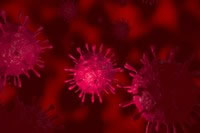New technique tracks proteins in single HIV particle
An interdisciplinary team of scientists from KU Leuven in Belgium has developed a new technique to examine how proteins interact with each other at the level of a single HIV viral particle. The technique allows scientists to study the life-threatening virus in detail and makes screening potential anti-HIV drugs quicker and more efficient. The technique can also be used to study other diseases.
 May 6, 2014 - Understanding how the human immunodeficiency virus (HIV) reproduces itself is crucial in the effort to fight the disease.
Upon entering the bloodstream, HIV viral particles, or virions, 'highjack' individual immune cells. The virion binds to
and then penetrates the immune cell. Once inside, the virion reprograms the genetic material of the immune cell to
produce more HIV virions. In this way, HIV disables the disease-fighting 'bodyguards' in our blood and turns
them into breeding machines for new HIV virions. May 6, 2014 - Understanding how the human immunodeficiency virus (HIV) reproduces itself is crucial in the effort to fight the disease.
Upon entering the bloodstream, HIV viral particles, or virions, 'highjack' individual immune cells. The virion binds to
and then penetrates the immune cell. Once inside, the virion reprograms the genetic material of the immune cell to
produce more HIV virions. In this way, HIV disables the disease-fighting 'bodyguards' in our blood and turns
them into breeding machines for new HIV virions.
Integrase plays a key role throughout this whole process: "Integrase is the HIV protein that
causes the genetic material of HIV to link to that of the hijacked cell. It ensures the programming of the
human cell upon infection. In our study, we wanted to track integrase during the different stages of
infection," explains postdoctoral researcher Jelle Hendrix (Department of Chemistry). The challenge
is to do this at the level of a single virion: "HIV has multiple ways of doing the same thing.
This is the case for cell penetration, for instance. So it is certainly useful to be able
to see exactly how the individual HIV virions are behaving."
Fluorescent
To achieve this, the researchers used single-molecule fluorescence imaging. They engineered a genetically
modified HIV virion that was capable of infecting the cell but incapable of reproducing inside it. The virion was
programmed to produce a fluorescent form of integrase. "This allowed us to examine the interactions of the
fluorescent integrase under the light microscope both in vitro in a single HIV virion as well as in a human
cell infected with it."
"We then used the technique to study both clinically approved and newly developed HIV inhibitors. Some
of these drugs were thought to affect interaction between integrase particles. With our new technique, we were able to
observe that this was indeed the case." The researchers' results
were published recently in the journal ACS Nano .
"There are already a few dozen medications available for HIV, but further research is essential.
Whenever HIV multiplies by hijacking an immune cell, there is a chance of mutation, and there is no guarantee
that an HIV drug will be able to handle that mutation. A medication may not be as effective over the course
of a patient's lifetime. Moreover, current HIV drugs are very expensive. Hence the importance of being
able to test anti-HIV medications quickly and efficiently."
Nano test tube
The good news is that this new technique can be broadly applied: "It may seem surprising, but we can
also use a genetically modified version of a dangerous virus to examine other pathogens. Essentially, we have created
a nano test tube out of an HIV virion, inside of which protein interactions can be studied. In principle, we can
make any protein fluorescent, be it from HIV, from another disease or from a human cell."
"Researchers have been studying protein interactions for some time, but studying them at the level
of a single viral particle was not possible until now," says Jelle Hendrix. "Our technique allows
scientists to quickly test many molecules - potential medications - for many diseases using minimal
material. In future research, we will be using the technique to study integrase proteins of other viruses."
###
Contact:
Newsroom
Phone: +32 16 32 40 15
news@kuleuven.be
Source: http://www.kuleuven.be/english/news/new-technique-tracks-proteins-in-single-hiv-particle
Reproduced with permission - "KU Leuven"
KU Leuven
For more HIV and AIDS News visit...
Positively Positive - Living with HIV/AIDS:
HIV/AIDS News |